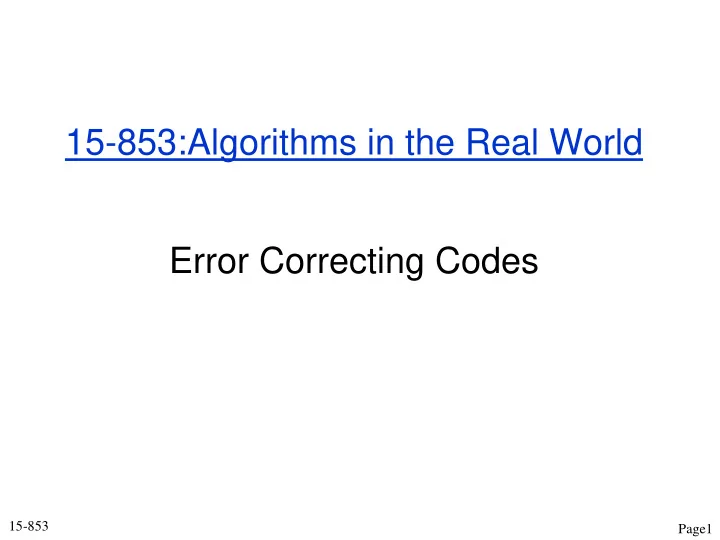

15-853:Algorithms in the Real World Error Correcting Codes 15-853 Page1
Welc**e t* t*e fi*st clas* o* t*is course. Y*u a** in f*r a f*n rid* th*s se*est*r! What do these sentences say? Why did this work? Redundancy! Codes are clever ways of judiciously adding redundancy to enable recovery under “noise” .
General Model “Noise” introduced by the channel: message (m) • changed fields in the codeword vector (e.g. a flipped bit). encoder • Called errors codeword (c) • missing fields in the codeword noisy vector (e.g. a lost byte). channel • Called erasures codeword’ (c’) decoder How the decoder deals with errors and/or erasures? • detection (only needed for message or error errors) • correction 15-853 Page3
Applications • Storage : CDs, DVDs, hard disks, Flash,… • Wireless : Cell phones, wireless links,.. • Satellite and Space : TV, Mars rover, … • Digital Television : DVD, MPEG2 layover, Reed-Solomon codes were traditionally the most used in practice. LDPC codes used for 4G (and 5G) communication. Algorithms for decoding are quite sophisticated. 15-853 Page4
Block Codes symbols (e.g., bits) s 1 s 2 s 3 s 4 s 5 … s k s k+1 s k+2 … s 2k … … block 1 block 2 message 1 message 2 Other kind: convolutional codes (we won’t cover it)… 15-853 Page5
Block Codes message (m) • Each message and codeword is of fixed size encoder • Notation: codeword (c) k = |m| noisy length of the message channel codeword’ (c’) n = |c| decoder length of the codeword message or error C = “code” = set of codewords 15-853 Page6
Simple Examples 3-Repetition code: k=1, n=3 <board> • How many erasures can be recovered? • How many errors can be detected ? • Up to how many errors can be corrected ? Errors are much harder to deal with than erasures. Why? Need to find out where the errors are! 15-853 Page7
Simple Examples Single parity check code: k=2, n=3 <board> Consider codewords as vertices on a hypercube. 110 111 codeword 010 011 n = 3 = dimensionality 2 n = 8 = number of nodes 100 101 001 000 15-853 Page8
Simple Examples 110 111 Single parity check code: k=2, n=3 010 011 100 101 001 000 • How many erasures can be recovered? • How many errors can be detected ? • Up to how many errors can be corrected ? Cannot even correct single error. Why? Codewords are too “close by” Let’s formalize this notion of distance.. 15-853 Page9
Block Codes message (m) In general, symbols come from an “ alphabet ” coder Notation: = alphabet codeword (c) q = | | = alphabet size noisy channel Question: codeword’ (c’) What alphabet did we use so far? decoder C S n (codewords) message or error 15-853 Page10
Block Codes message (m) Notion of distance between codewords: coder D (x,y) = number of positions s.t. x i y i codeword (c) noisy channel minimum distance of a code d = min{ D (x,y) : x,y C, x y} codeword’ (c’) decoder Code described as: (n, k, d) q message or error 15-853 Page11
Binary Codes 15-853 Page12
Example of (6,3,3) 2 systematic code message codeword 000 000 000 001 001 011 Definition : A Systematic code 010 010 101 is one in which the message appears in the codeword 011 011 110 100 100 110 101 101 101 110 110 011 111 111 000 15-853 Page13
Error Correcting One Bit Messages How many bits do we need to correct a one bit error on a one bit message? 110 111 10 010 11 011 100 101 01 00 001 000 3 bits 2 bits 0 -> 000, 1-> 111 0 -> 00, 1-> 11 (n=3,k=1,d=3) (n=2,k=1,d=2) In general need d 3 to correct one error. Why? 15-853 Page14
Role of Minimum Distance Theorem: A code C with minimum distance “d” can: 1. detect any (d-1) errors 2. recover any (d-1) erasures 3. correct any <write> errors Proof: <Will be part of homework> Intuition here.. minimum-distance-decoding.. 15-853 Page15
Desiderata We look for codes with the following properties: 1. Good rate: k/n should be high (low overhead) 2. Good distance: d should be large (good error correction) 3. Small block size k 4. Fast encoding and decoding 5. Others: want to handle bursty/random errors, local decodability, ... 15-853 Page16
We will begin next class with Hamming Codes 15-853 Page17
Recommend
More recommend